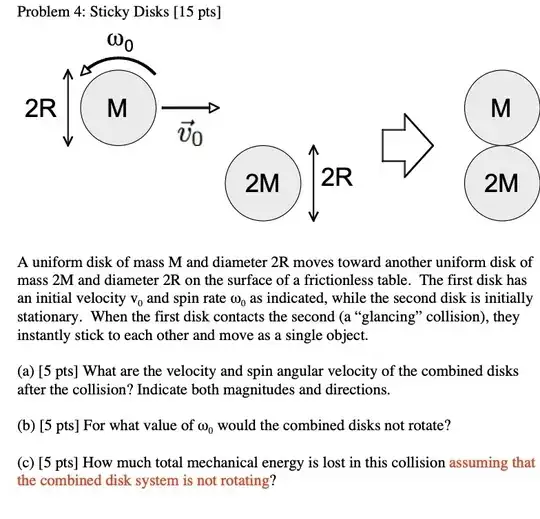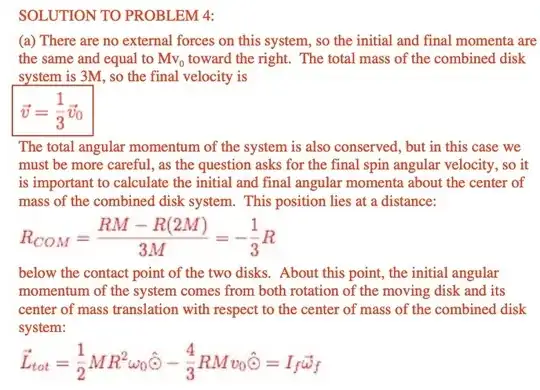I am working on answering part (a) and here is what I got: By conserving linear momentum, we have that $$mv_0 =(3M)v_f \hspace{3mm}\implies \hspace{3mm} v_f =\frac{1}{3}v_0$$ Now, in order to conserve angular momentum, we have to choose a point from which to calculate the moment of inertia of the system; we choose the center of mass. Choosing the origin to be the center of mass of the $2M$ disk, we have that $$y_{com} =\frac{2RM}{3M} =\frac{2}{3}R$$ That is we have that the center of mass of the system is $\frac{2}{3}$ of the radius away from the center of mass of the $2M$ disk and $\frac{4}{3}$ of the radius away from the center of mass of the $M$ disk. Now, by the parallel axis theorem, the new moment of inertia about the center of mass of the system for the smaller disk is $$I_s =I_{\text{com}}+M\left(\frac{4}{3}R\right)^2 = \frac{1}{2}MR^2 +\frac{16}{9}MR^2 =\frac{41}{18}MR^2$$ and the new moment of inertia for the larger disk is $$I_b =I_{\text{com}}+(2M)\left(\frac{2}{3}R\right)^2 =\frac{1}{2}(2M)R^2+\frac{8}{9}MR^2 =\frac{17}{9}MR^2$$ Hence, our moment will be $$I=I_s+I_b = \frac{25}{6}MR^2$$ Now, for the initial angular momentum about the systems center of mass, we have $$\mathbf{L}_0 = I_s \omega_0^\odot +\left(\frac{4}{3}R\right)Mv_0^\otimes = \left( \frac{41}{18}MR^2 \right)\omega_0^\odot +\left(\frac{4}{3}R\right)Mv_0^\otimes$$ At this point I checked my work with the given solution and I noticed that they used the moment of inertia about the center of mass for the small disk for one part of the calculation and they then used the moment about the center of mass of the system in the same calculation.
At the bottom line they have given above, it says $$L_0 = \frac{1}{2}MR^2\omega_0 \odot-\text{yada yada}$$ but that's the wrong moment of inertia no? I thought we would have to stay consistent with our choice of axes throughout the entire momentum calculation. Im sure I am missing something small but any guidance would be appreciated.
EDIT: My question is precisely about the underlying physics concepts. I do not want anyone to check my homework and I asked the question after checking to see it it was suitable for the site. It is. My question is:
Why can we choose two different moments of inertia under the same momentum calculation?


